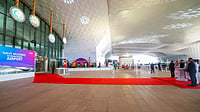Airport Overview
Navi Mumbai International Airport, a monumental greenfield project, stands as a significant development in Maharashtra. Its primary purpose is to relieve
the existing pressure on Chhatrapati Shivaji Maharaj International Airport (CSMIA) in Mumbai. The airport is meticulously designed to become a crucial transport hub, boosting connectivity for both passengers and cargo. Its strategic location and advanced infrastructure suggest a considerable impact on the economic and infrastructural development of the region. As Mumbai's second airport, it is poised to accommodate a large influx of travelers and handle substantial cargo operations, streamlining travel and trade. The architecture and design showcase the latest advances, promising a seamless and efficient experience for everyone. The inauguration of the airport will mark a pivotal moment in Mumbai's aviation history, enabling future growth and opportunity.
Modern Facilities
The Navi Mumbai International Airport integrates cutting-edge facilities designed to enhance passenger experience and operational efficiency. These modern amenities ensure seamless processes from check-in to departure. The inclusion of advanced technologies, from baggage handling systems to digital information displays, provides comfortable and easy navigation. Furthermore, the airport will accommodate various essential services, including numerous retail outlets, restaurants, and lounges, providing travelers with a comprehensive experience. The airport also boasts state-of-the-art security measures, ensuring a safe environment. The modern facilities offer a more streamlined experience. The infrastructure is tailored to meet the growing demands of air travel, signifying a major boost for both domestic and international operations. Such comprehensive upgrades solidify Navi Mumbai International Airport's status as a leading aviation hub.
Key Architectural Features
The architecture of the Navi Mumbai International Airport has been designed with both functionality and aesthetics in mind. Its design reflects modern trends while incorporating elements that contribute to operational efficiency. The project incorporates sustainable design principles and aims to minimize its environmental footprint. The architecture prioritizes natural light and ventilation throughout the terminal buildings, enhancing the comfort of the travelers. Moreover, the layout is organized in a way that facilitates easy navigation, allowing for quick transit times. The structures boast expansive terminals, designed to accommodate both domestic and international flights. The design also ensures smooth traffic flow, allowing for efficient ground transportation, including roadways and parking facilities. Overall, the architectural features reflect its vision to be a world-class airport, offering an improved experience.
Strategic Location
The strategic location of the Navi Mumbai International Airport is a vital element in its success. Positioned to improve connectivity and reduce congestion, the airport is placed to provide better access. Being in close proximity to major roadways and public transport, it will ease the journey to and from the airport. This allows for efficient movement, supporting regional economic growth and facilitating broader trade. Moreover, the airport's strategic placement will benefit neighboring towns, promoting development in the surrounding areas. The location also helps in attracting both business and leisure travelers. This location will be a catalyst for economic opportunities within the region. Its location is designed to be central, thus contributing to Mumbai's status as a crucial hub for transportation.
Interconnectivity Benefits
The design of the Navi Mumbai International Airport features an emphasis on interconnectivity, optimizing transportation within Mumbai and beyond. It is linked to key transport networks, ensuring smooth transfers for passengers. This includes road networks, and public transport connections. The airport's layout incorporates efficient systems to manage ground transport, making it easier for travelers. This integration simplifies journeys and reduces congestion, resulting in a better travel experience. These seamless connections will benefit both business travelers and tourists. The goal is to make the airport an easily accessible transportation point. This network will contribute to the airport's operational efficiency and boost its capacity to manage a high volume of traffic.
Cargo Operations
Navi Mumbai International Airport is planned to significantly enhance cargo operations. It will include dedicated cargo facilities, designed to handle a wide range of goods. This will lead to smoother and more efficient movement of goods. The dedicated spaces allow for faster processing and storage of cargo, supporting international and domestic trade. Furthermore, the airport's proximity to industrial areas will facilitate the seamless transfer of goods. This will benefit businesses across numerous sectors. The aim is to offer comprehensive cargo services, including warehousing, handling, and customs clearance. This development will enable Mumbai to bolster its position as a vital commercial hub. The airport will play a crucial role in promoting regional and national economic development.
Capacity and Growth
The Navi Mumbai International Airport has been designed to manage a significant passenger volume. The airport's expansion plan includes the potential for further growth and increased capacity. This allows the airport to adapt to future demands. This expanded capacity is projected to benefit both domestic and international travelers. The airport will support a growing number of flights and improve its overall operational efficiency. This strategy will support economic growth and accommodate increasing volumes of both passenger and cargo traffic. The ability to expand will solidify Mumbai's position as a crucial aviation center. The airport's ability to expand will contribute to the region's infrastructure, fostering an environment conducive to both business and tourism.


